Abstract
Mandarin fruits with good physicochemical quality are desired for the fresh fruit market. The ease of crosses among citrus taxa has been used to expand genetic variability and select new varieties for different fruit markets. With the aim of selecting new commercial varieties, eleven hybrids obtained from the cross between Murcott tangor and Ponkan mandarin were grafted on Rangpur lime rootstock and evaluated for genetic and phenotypical characteristics. It was observed that there are significant differences in the fruit shape, content, and organoleptic characteristics in juice and differential responses to Alternaria alternate, the causal agent of the Alternaria brown spot (ABS) disease. The phenotypic and molecular characterization showed two groups of hybrids, those that resemble Ponkan and others with characteristics closer to the parental Murcott. There are significant differences in the period of fruit maturation among the hybrids and their parents. Considering the parents stand out as the main commercial varieties in the Brazilian mandarin fresh fruit market, these new hybrids have great potential for commercial acceptance and could be an excellent option to extend the period of supply of mandarins. Genetic and phenotypical information will be fundamental for the registration and/or protection of new varieties, which are essential steps that precede the commercial release to the producer.
1. Introduction
The São Paulo State is the largest Brazilian producer of mandarins, mainly Ponkan (Citrus reticulata Blanco) and Murcott tangor (C. sinensis L Osbeck × C. reticulata), followed by Willow Leaf mandarin (C. delicious Tenore) and Cravo mandarin (C. reticulata) [1]. However, in some Brazilian regions, a reduction in planted area and mandarin production has been observed [1]. Among the factors that contributed to the decrease in mandarin orchards is the high susceptibility to diseases such as greening (Huanglongbing, HLB) and Alternaria brown spot (ABS) [2]. Different from what happens with greening, with necessary vector transmission, and without citrus resistance, ABS is caused by the fungus Alternaria alternata (Fr.) Keissl, affecting mandarins, and most commercial varieties are highly susceptible to the pathogen. The symptoms of the ABS disease can be observed on fruits, branches, and young leaves, which are characterized by brown to black spots surrounded by a yellow halo and variable size, frequently leading to the expansion of the lesions and the collapse of the foliar tissues due to the action of the fungal toxin or death of the shoot [3,4].
Currently, most of the varieties are not suitable for the foreign market, mainly because they are not seedless varieties, although they meet the taste requirements of the local consumer. The diversification of mandarin varieties has been one of the main demands and is a big challenge to citrus breeding. Hence, these breeding programs should consider the phytosanitary threats and the extension of the fruit supply period to attend to new markets. Previous studies have shown breeding techniques, such as mutation and natural or artificial hybridization, which are interesting for developing and selecting new cultivars that include desirable traits, such as fruits with seedless sweetness, early maturation, and tolerance to ABS and other citrus diseases, such as HLB [2]. Interspecific hybrids are increasingly being generated in citrus breeding programs [5,6,7] and constitute an important strategy to expand variability and genetics, and they have the potential to become new commercial varieties [8,9].
Here, with the aim of offering new mandarins to producers and the citrus market, eleven hybrids obtained from artificial hybridization between Murcott tangor (MT, accession IAC 221) and Ponkan mandarin (PT, accession IAC 172) were evaluated using 78 descriptors. These descriptors have been established for mandarins and hybrids, including the physicochemical characteristics of the fruits, response to the in vitro inoculation of A. alternata, and characterization by TRAPs and SSR molecular markers. These molecular markers are used in our plant genetic improvement programs, and they are important tools for faster and more efficient plant production, which has advantages for agricultural production.
2. Materials and Methods
The mandarin hybrids (eleven hybrids) belong to the accessions of the Active Germplasm Bank of the Centro de Citricultura Sylvio Moreira/IAC (Cordeirópolis, SP), produced with controlled crosses between Murcott tangor (MT, accession IAC 221) and Ponkan mandarin (PT, accession IAC 172) in 2003, and planted in the field in the municipality of Matão, SP, in December 2011. The original plants, from seeds, are kept in 60 L pots in a greenhouse. For multiplication and evaluation in the field, the hybrids were grafted onto Rangpur lime (C. limonia Osbeck). The experimental design was a randomized block design, with one plant per plot and four replications, spaced with 6 m between rows and 3 m between plants in the same row, totaling 60 plants. The plants were eleven hybrids (TMxPT 1, 2, 3, 4, 5, 7, 8, 9, 11, 12, and 13), Pera Sweet Orange, Cravo IAC 182 mandarin (C. reticulata Blanco), Murcott tangor, and Ponkan mandarin.
2.1. Morphological Characterizations of Mandarin and Their Hybrids
The analyses were carried out according to the 78 descriptors of mandarins and their hybrids established by the Ministry of Agriculture, Livestock, and Supply/MAPA in 2007 (https://www.gov.br/agricultura/pt-br/assuntos/insumos-agropecuarios/insumos-agricolas/protecao-de-cultivar/frutiferas, accessed on 1 August 2024).
Additionally, the descriptors with discriminatory potential for the new hybrids were evaluated. The evaluations were conducted on samples collected from the 4 replicates/plants of each hybrid.
2.2. Physical–Chemical Analyses
Fifteen fruits were harvested monthly from each plant replication, collected from the outer portion of the canopy, at a height of 1.0 and 2.0 m above the ground and along the entire perimeter of each plant. The collected fruits were sent to the Quality and Post-Harvest Laboratory of the Citriculture Center/IAC.
The total mass of the fruits was measured using a semi-analytical balance (Filizola, São Paulo, SP, Brazil) and then divided by the number of fruits. The juice yield was evaluated by crushing 5 fruits in the ICO extractor (International Centenary Organization) model OTTO 1800 (Centenário, Limeira, SP, Brazil) and calculated as the ratio of juice mass to fruit mass, expressed as a percentage.
For chemical analyses, the soluble solids content was determined using a B&S refractometer, model RFM 330 (Konica Minolta, Tokyo, Japan), and expressed in °Brix. The data were corrected for temperature and juice acidity. Acidity was determined by titrating 25 mL of juice with a sodium hydroxide solution (normality 0.3125) using phenolphthalein as an indicator. The soluble solids/acidity ratio was calculated by normalizing the acidity value to 1.
2.3. Response to Alternaria Alternata Inoculation
The assays were conducted in vitro using detached leaves to assess the response to Alternaria brown spot (ABS). In addition to the hybrids, their parents (Murcott tangor and Ponkan mandarin) were included as susceptibility standards, while Cravo IAC 182 mandarin (C. reticulata Blanco) and Pera IAC sweet orange (C. sinensis Osbeck) served as the resistance standard. The experiment took place at the Sylvio Moreira Citriculture Center of the Agronomic Institute (IAC) using healthy leaves from the plants maintained in screened greenhouses at the Citrus Germplasm Active Bank.
Fungus inoculation was carried out on the young leaves following the method described by Peever et al. [10]. A monosporic isolate of A. alternata was obtained from typical lesions on Murcott tangor fruits and maintained in Potato Dextrose Agar (PDA) medium under a 12-h photoperiod at 27 °C in a Bio-Oxygen Demand (BOD) incubator. After preparing the inoculum, young leaves from each genotype were collected in the field, washed with sterilized distilled water, and placed in Petri dishes (25 mL) with sterilized filter paper and moistened cotton.
For inoculation, two plates were used per individual, each containing four leaves, with eight replications per accession. The leaves were arranged with the abaxial side facing upwards and inoculated with a spore suspension of A. alternata (105 conidia mL−1), applying 2 mL per leaf. The plates were incubated at 27 °C in the BOD incubator for three days under the conditions previously described.
Disease symptoms were evaluated 24, 48, and 72 h after inoculation following the diagrammatic scale by Martelli et al. [11], where “0” indicates leaves without symptoms, and scores from 1 to 9 correspond to 0.3, 3.5, 8, 15, 34, 61, 80, 90, and 97 percent of the leaf area affected by A. alternata, respectively. At the conclusion of the evaluations, the area under the disease progress curve (AUDPC) was computed. Fruit quality parameters and ABS leaf severity were evaluated using the statistical program SASM-AGRI [12]. When necessary, the data were transformed using the formula √x + 1. Means were compared using the parametric Scott–Knott test [13] at a 5% significance level.
2.4. Molecular Characterization
DNA was extracted from dried leaves using the methodology described by Murray and Thompson [14].
Potentially polymorphic TRAP (Target Region Amplification Polymorphism) markers were selected for the mandarin accessions, along with the microsatellite (SSR) markers previously established in our studies [15]. Eight combinations of TRAP primers were used. For the microsatellite markers, nine pairs of primers from citrus ESTs (Expressed Sequences Tags)—CitEST and four pairs of genomic sequence primers [16] were used. Amplification reactions (PCR) were conducted using 100 ng of DNA in a total volume of 15 μL in a Vereti 96-Well Thermal Cycler following the standard methodologies described by the authors [16].
For both markers used, the PCR products were visualized on a 3% agarose gel with SYBR safe DNA gel stain (Thermo Fisher Scientific, Invitrogen, Waltham, MA, USA), and a 100 pb DNA ladder of 100 pb was used to calculate the band sizes. The gels were visualized using a photodocumenter and polymorphisms were analyzed. The amplification products were assessed using a binary data matrix, with band presence (1) and absence (0) assigned across the 14 genotypes. Genetic similarity between individuals was calculated using the Jaccard coefficient, and dendrograms were constructed using the UPMGA (Unweighted Pair Grouped Method Average) method. The clustering algorithm’s efficiency was assessed using cophenetic correlation coefficients, analyzed in the NTSYS program (Numerical Taxonomy and Multivariate Analysis System) v. 2.02 [17].
The number of alleles per locus, observed heterozygosity (Ho), and expected heterozygosity (Hexp) were evaluated for the microsatellite markers. Additionally, the polymorphic content index (PIC) was analyzed for both the markers, microsatellites and TRAPs. The PIC values were estimated using the CERVUS 2.0 software [18] for microsatellites and the spreadsheet developed by Farooq [19] for TRAPs.
3. Results and Discussion
3.1. Morphological Characterization of Mandarins and Their Hybrids
All the morphological descriptors were evaluated in the hybrids to compare them with the parents and Cravo mandarin cultivars, enabling their characterization and differentiation from the other cultivars. Despite all the analyzed leaves having a crenate margin incision, there was a greater predominance of acute leaves overall. However, exceptions were noted for TMxTP 3, TMxTP 11, TMxTP 13, and Cravo mandarin, which displayed acuminate leaves. Additionally, individuals TMxTP 2, TMxTP 4, and TMxTP 8, along with the Murcott tangor, exhibited obtuse leaves (Figure 1).
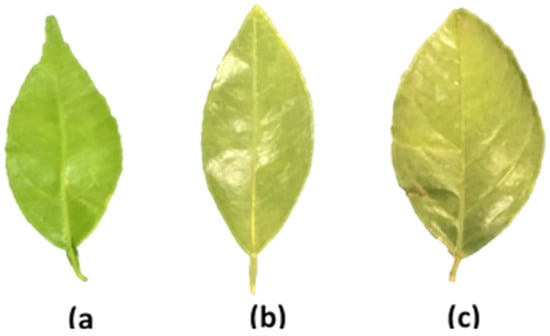
Figure 1.
Images photographed at the time of leaf collection. The illustration of leaf apex types. (a) Cravo mandarin—acuminate; (b) TMxTP5—acute; (c) TMxTP2—obtuse.
The TMxTP 11 hybrid presented larger flowers, with a larger structure of petals and stamens compared to the other accessions. In terms of color, the majority exhibited a light-yellow hue, with only TMxTP 8 standing out for its medium yellow coloration (Figure 2).
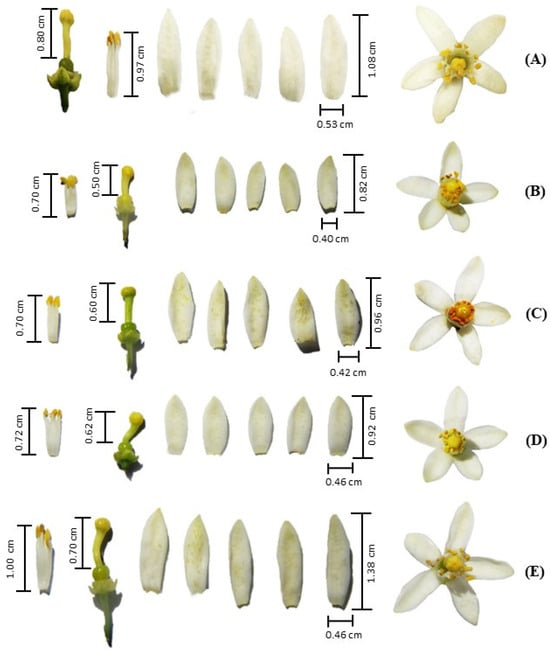
Figure 2.
Images and dimensions of petals, stamens, styles, and flower colors of hybrids (A) TMXTP 3; (B) TMXTP 5; (C) TMXTP 8; (D) TMXTP 9; and (E) TMXTP 11.
3.2. Physical–Chemical Analyses of Fruits
Based on the visual phenotypic evaluations of the fruits (Figure 3 and Figure 4), it was evident that some hybrids exhibited morphological similarities to the female parent Murcott tangor, while others resembled the male parent, Ponkan mandarin, and were thus classified as Murcott-like and Ponkan-like, respectively.
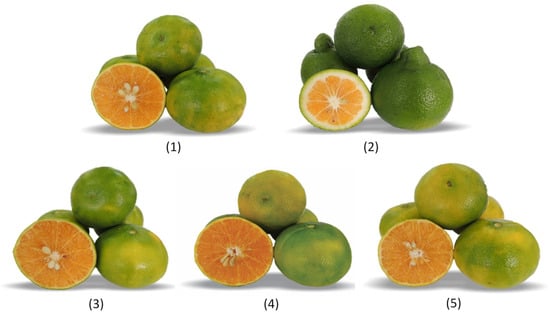
Figure 3.
Illustration of fruits collected for initial physicochemical analysis. (1) Murcott tangor; (2) TMxTP 2; (3) TMxTP 4; (4) TMxTP 7; (5) TMxTP 8.
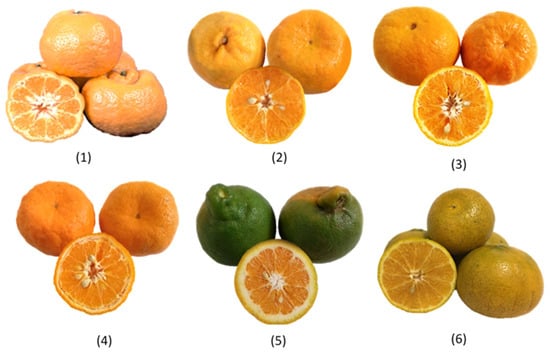
Figure 4.
Illustration of fruits collected for initial physicochemical analysis. (1) Ponkan; (2) TMxTP 3; (3) TMxTP11; (4) TMxTP13; (5) TMxTP1; (6) TMxTP12.
Considering the physicochemical analyses of the fruits and juice, the evaluated hybrids were medium-sized, with a mass greater than 100 g, and an appropriate juice yield for the variety, reaching percentages above 35% and 42% of juice content (Figure 5 and Figure 6), established as the minimum standard for commercialization for Ponkan and Murcott, respectively [20].
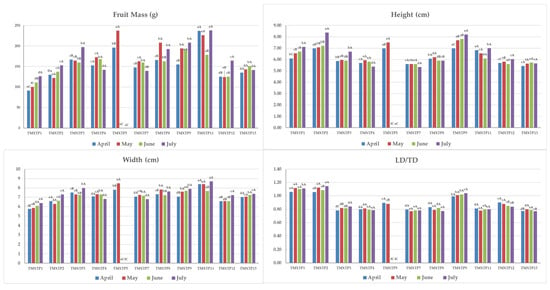
Figure 5.
Fruit evaluations from the Murcott tangor and Ponkan mandarin hybrids on 4 collection dates. Means followed by the same letter in the row (uppercase) and column (lowercase) belong to the same group by the Scott–Knott test (p < 0.05); LD/TD (longitudinal diameter/transverse diameter).
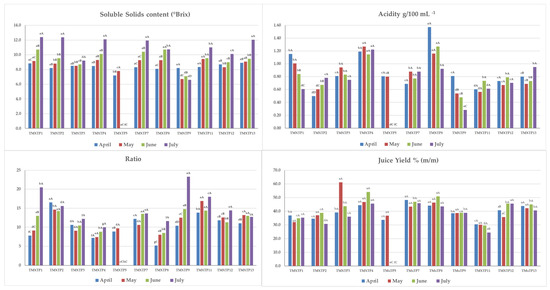
Figure 6.
Physicochemical evaluation of the juice from the Murcott tangor and Ponkan mandarin hybrids on 4 collection dates. Means followed by the same letter in the row (uppercase) and column (lowercase) belong to the same group by the Scott–Knott test (p < 0.05);.
Among the hybrids most like Murcott tangor, TMxTP 4 and TMxTP 8 showed lower ratio values and later maturation (Figure 6), while accessions TMxTP 7 and TMxTP 12 were the earliest compared to the other individuals, presenting ratio values greater than 10.0 in April.
Murcott tangor, which has the second highest economic importance among mandarins in Brazil, represents about 20% of the total planted area. It has average values of a soluble solids content of 12.6 °Brix, 0.9 acidity, and a ratio of 13.7 for the State of São Paulo, with harvests occurring between July and October depending on the climatic conditions of the growing region. Thus, among the analyzed hybrids, there are materials with the potential to extend the fruit supply period in the Murcott group. However, for Ponkan-like hybrids, the vast majority reached a satisfactory ratio in April (Table 1), where the value was above the 9.5 limit established as the minimum quality standard for the Ponkan variety [21], indicating their precocity compared to the other accessions (Figure 5 and Figure 6; Table 1). The main harvest of Ponkan in the Central region of the State, where the experimental area was established, takes place between the months of May and June, and the supply of fruits outside this period in the country is due to the harvest in other growing regions. Therefore, for the Ponkan group, there are also hybrids with the potential to extend the fruit supply period, which is an important and necessary characteristic. It should be noted that Ponkan represents more than 80% of the orchards and is preferred by Brazilian consumers.

Table 1.
Time of fruit maturation and the number of seeds of the eleven Murcott tangor and Ponkan mandarin hybrids. Means followed by the same letter in the row and in the column belong to the same group by the Skott–Knott test (p < 0.05).
In general, the evaluation for the number of seeds did not show significant variations, although the hybrids TMxTP 8, TMxTP 11, and TMxTP 2, showed the lowest numbers of 11.6, 12.4, and 13.0, respectively (Table 1).
3.3. Reaction of Genotypes to Inoculation with Alternaria alternata
After 24 h of inoculation of the fungus on leaves in vitro, most of the hybrids (66.7%) developed leaf lesions similar to the susceptible parents, Murcott tangor and Ponkan mandarin. The percentage of symptoms in the leaf area varied from 0 to 4.94%.
At 48 and 72 h after inoculation, Cravo mandarin exhibited symptoms of A. alternata, although at a significantly lower level compared to the positive controls, which can be considered tolerant, as it did not differ statistically from the asymptomatic accessions. Although this access is described as resistant in many studies, ref. [22] reported that in in vitro evaluations, the inoculated leaves were symptomatic, suggesting that resistance was only observed in in vivo inoculation. This indicates that the plant’s defense mechanisms remained active, possibly due to the controlled humidity in in vitro environment, which is conducive to the proliferation of the fungus.
The hybrids TMxTP 1, TMxTP 3, and TMxTP 11, along with the negative control Pera Sweet orange, demonstrated resistance by not exhibiting symptoms on detached leaves. Despite the susceptibility of the parents Murcott tangor and Ponkan mandarin to A. alternata, it is possible to obtain resistant hybrids. According to Gulsen et al. [23] and Cuenca et al. [24], susceptibility follows dominant inheritance, while resistance follows recessive inheritance. This suggests that both parents may be heterozygous for this trait.
The individual TMxTP 5, although it exhibited symptoms on its leaves, showed lower values over the hours of inoculation compared to the positive controls. Five hybrids (TMxTP 7, 8, 9, 12, and 13) were the most symptomatic, reaching AUDPC values above 1000.0 (Table 2), which were significantly higher compared to the other hybrids. Moreover, these values exceeded those of Ponkan and Murcott, showing statistical differences across the hours after inoculation. Among them, the TMxTP 8 hybrid was the most susceptible, reaching an AUDPC of 3273.7, with necrotic symptoms appearing as early as 48 h, indicating greater disease severity.

Table 2.
Severity and area under the disease progress curve (AUDPC), evaluated after inoculation with A. alternata in the mandarin hybrids and their parents. Means followed by the same letter in the line (upper case) and in the column (lower case) belong to the same group by the Skott–Knott test (p < 0.05).
After 72 h after inoculation, four individuals (26.6%) were asymptomatic (the hybrids TMxTP 1, TMxTP 3, TMxTP11, and the parental Pera Sweet orange), while eleven genotypes were symptomatic (73.3%). The symptomatic hybrids included TMxTP 2, TMxTP 4, TMxTP 5, TMxTP 7, TMxTP 8, TMxTP 9, TMxTP 12, and TMxTP 13, along with the controls (Cravo and Ponkan mandarins) and the parental Murcott tangor, exhibiting varying levels of disease severity (Table 2).
3.4. Molecular Characterization
The mandarin hybrids and their parents were evaluated using 21 TRAP and microsatellite markers. Thirteen pairs of microsatellite primers, nine EST markers, and four genomic markers (Table 3) exhibited polymorphisms among the parents and their hybrids.

Table 3.
Description and variability parameters of thirteen microsatellite loci in 14 mandarin and hybrid accessions.
For genotyping, the number of alleles varied from 2 to 3 per locus, averaging 2.27, while the fragment sizes for the different alleles ranged from 100 to 400 bp (Table 3). Observed heterozygosity ranged from 0.071 to 0.857, and the expected ranged from 0.071 to 0.685 (Table 3). The locus CCSM-EST-169 exhibited the lowest polymorphism index (0.067) while the locus CCSM-EST-187 had the highest index (0.587), with an overall mean of 0.381 (Table 3).
For eight combinations of TRAP primers, 68 bands were produced, and the number of polymorphic loci ranged from 1 to 8, resulting in a polymorphism rate of 55.8%. The primers with the highest values of the polymorphic content index (PIC) were the combinations Trap1 + Arbi1, Trap12 + Arbi6, and Trap5 + Arbi5, each exceeding 0.45. Conversely, the primer Trap10 + Arbi3 exhibited the lowest polymorphic index (0. 08). Thus, the average PIC was 0.34 (Table 4).

Table 4.
Description and variability parameters of the eight primer combinations for the fourteen genotypes.
In the similarity analyses, both for the microsatellite markers and the TRAPs, it was possible to observe the resemblance of different accessions to their potential parents, forming two distinct groups.
For the microsatellite markers, the dendrogram (Figure 7) depicted the presence of the male parent, Ponkan mandarin, along with its hybrids TMxTP 13 and TMxTP 12 in group 1. In the second group, the female parent, Murcott tangor, was grouped with the remaining hybrids from the cross, along with their respective similarities. However, the Cravo mandarin was not closely associated with any hybrid, demonstrating a similarity of (0.47) in comparison to the other individuals.
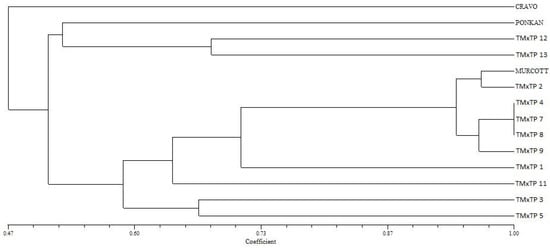
Figure 7.
Dendrogram of the relationship among the 14 accessions based on the UPGMA clustering analysis of the similarity matrix of the 13 microsatellite loci, generated by the NTSYS software, version 2.0 [17].
Nevertheless, the hybrid TMxTP 2 was found to be closer to the parental Murcott tangor, as well as to the hybrids 4, 7, and 8, given their similarity close to 0.90 with the tangor. Although the hybrids TMxTP 2, 4, 7, and 8, along with the parental Murcott tangor, exhibit very similar phenotypic characteristics when observed in the field, individual TMxTP 2 has a neck in the fruit that differs significantly from the other hybrids fruits (Figure 3).
It was observed that the individuals TMxTP 9, TMxTP 1, and TMxTP11 were also associated with the parental Murcott, displaying similarities of 0.90, 0.70, and 0.64, respectively. Finally, the hybrids TMxTP 5 and TMxTP 3 were the least genetically similar to Murcott, with a similarity of 0.58.
The dendrogram generated by the TRAP marker (Figure 8) also facilitated the observation of two distinct groups, with certain hybrids grouped with the Ponkan mandarin and others with Murcott tangor. The Cravo mandarin exhibited a significant dissimilarity (0.68) in relation to the hybrids, consistent with the findings from the microsatellite markers.
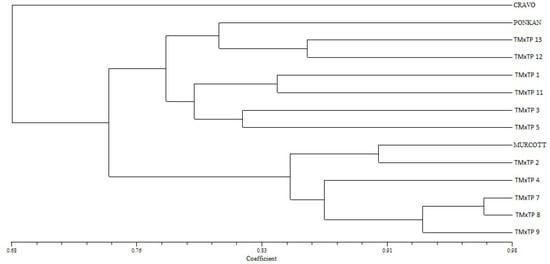
Figure 8.
Dendrogram of the relationship among the 14 accessions based on the UPGMA clustering analysis of the similarity matrix of the 68 bands observed by TRAP markers, generated by the NTSYS software, version 2.0 [17].
In group 2, the female parent, Murcott tangor, was present, along with the same hybrids observed previously, namely TMxTP 2, 4, 7, 8, and 9. Within this clade, the similarities varied, indicating that no hybrid was identical to another. Such variation can be attributed to the type of marker used, as TRAP markers generate numerous polymorphic bands compared to microsatellite markers, making them more effective for detecting polymorphisms and distinguishing between individuals.
The dendrogram analysis revealed that the TMxTP hybrids 13, 12, 1, 11, 3, and 5 clustered together with the Ponkan mandarin. However, the phenotypic evaluation of the fruit traits indicated that the hybrids TMxTP 1 and 12 exhibited distinct characteristics compared to the others, particularly in terms of color, shape, and peel adhesion.
4. Conclusions
Among the hybrids evaluated, morphological and organoleptic differences were observed, as well as variations in response to Alternaria brown spot. Two distinct groups of hybrids were identified, one similar to Ponkan and the other to the Murcott parent. Considering these desirable quality characteristics for the fresh fruit market, these hybrids hold great potential and represent an excellent option for extending the tangerine supply period.
Author Contributions
Conceptualization: M.C.-Y., V.M.N., and M.B.; methodology: A.L.D. and T.M.C.; formal analysis and investigation: M.C.-Y., A.L.D., F.R., T.M.C., V.M.N., and M.B; original draft preparation: M.C.-Y. and V.M.N.; supervision: M.C.-Y.; funding acquisition: M.C.-Y. All authors have read and agreed to the published version of the manuscript.
Funding
This work was financed by the São Paulo Research Foundation (FAPESP Proc. No. 2014/50880-0, 2017/24564-1 and 2020/07045-3). A.L. Dezotti (FAPESP—2015/23839-1) is grateful for your fellowship. M.C.Y. is the recipient of research fellowships from CNPq (Proc. No. 313657/2023-8).
Institutional Review Board Statement
Not applicable.
Informed Consent Statement
All the individuals included in this section have read and agreed to the published version of the manuscript.
Data Availability Statement
The data presented in this study are available upon request from the corresponding author.
Acknowledgments
We thank Fapesp and CNPq.
Conflicts of Interest
The authors declare that the research was conducted in the absence of any commercial or financial relationships that could be construed as a potential conflict of interest.
References
- Instituto Brasileiro de Geografia e Estatística. IBGE. 2021. Available online: https://www.ibge.gov.br (accessed on 10 March 2024).
- Bastianel, M.; Martinelli, R.; Devite, F.T.; Cristofani-Yaly, M.; Ferreira, R.d.V.; Stuchi, E.S.; Azevedo, F.A.d. Reaction of mandarins to the Alternaria Brown spot and huanglongbing: Identification of potential varieties for these diseases to be managed in the field. Horticulturae 2023, 9, 641. [Google Scholar] [CrossRef]
- Timmer, L.W.; Darhower, H.M.; Zitko, S.E.; Peever, T.L.; Ibanez, A.M.; Bushong, P.M. Environmental factors affecting the severity of Alternaria brown spot of citrus and their potential use in timing fungicide applications. Plant Dis. 2000, 84, 638–643. [Google Scholar] [CrossRef] [PubMed]
- Vicent, A.; Badal, J.; Asensi, M.J.; Sanz, N.; Armengol, J.; Garc, J. Laboratory evaluation of citrus cultivars susceptibility and influence of fruit size on Fortune mandarin to infection by Alternaria alternata pv. citri. Eur. J. Plant Pathol. 2004, 110, 245–251. [Google Scholar] [CrossRef]
- Cuenca, J.; Navarro, L.; Aleza, P. Advances in mandarin breeding. In Achieving Sustainable Cultivation of Tropical Fruits; Burleigh Dodds Science Publishing: London, UK, 2019; Volume 1, pp. 183–212. [Google Scholar]
- Stitou, M.; Fadli1, A.; Chetto, O.; Talha, A.; Benkirane, R.; Benyahia, H. Fruit quality analysis in four new mandarin hybrids during maturation period. Annu. Res. Rev. Biol. 2017, 18, 1–10. [Google Scholar] [CrossRef]
- Tarancón, P.; Giménez-Sanchis, A.; Aleza, P.; Besada, C. Selection of new lateseason mandarin cultivars based on sensory changes and consumer acceptance after fruit cold storage. Agronomy 2021, 11, 116. [Google Scholar] [CrossRef]
- .Yu, Q.; Dai, F.; Russo, R.; Guha, A.; Pierre, M.; Zhuo, X.; Wang, Y.Z.; Vincent, C.; Gmitter, F.G., Jr. Phenotypic and Genetic Variation in Morphophysiological Traits in Huanglongbing-Affected Mandarin Hybrid Populations. Plants 2023, 12, 42. [Google Scholar] [CrossRef]
- Deng, H.; Achor, D.; Exteberria, E.; Yu, Q.; Du, D.; Stanton, D.; Liang, G.; Gmitter, F.G., Jr. Phloem regeneration is a mechanism for Huanglongbing-tolerance of “Bearss” lemon and “LB8-9” Sugar Belle® mandarin. Front. Plant Sci. 2019, 10, 277. [Google Scholar] [CrossRef] [PubMed]
- Peever, T.L.; Canihos, Y.; Olsen, L.; Ibañez, A.; Liu, Y.C.; Timmer, L.W. Population Genetic Structure and Host Specificity of Alternaria spp. Causing Brown Spot of Minneola Tangelo and Rough Lemon in Florida. Phytopathology 1999, 89, 851–860. [Google Scholar] [CrossRef] [PubMed]
- Martelli, I.B.; Pacheco, C.A.; Bastianel, M.; Schinor, E.H.; Conceição, P.M.; Azevedo, F.A. Diagrammatic scale for assessing foliar symptoms of alternaria brown spot in citrus. Agron. Sci. Biotechnol. 2016, 2, 56–61. [Google Scholar] [CrossRef]
- Althaus, R.A.; Canteri, M.G.; Giglioti, E.A. Tecnologia da Informação Aplicada ao Agronegócio e CIÊNCIAS ambientais: Sistema para Análise e Separação de Médias Pelos Métodos de Duncan, Tukey e Scott-Knott; Parte 1; Anais do X Encontro Anual de Iniciação Científica: Ponta Grossa, Brazil, 2001; pp. 280–281. [Google Scholar]
- Scott, A.; Knott, M. A Cluster Analysis Method for Grouping Means in the Analysis of Variance. Biometrics 1974, 30, 507. [Google Scholar] [CrossRef]
- Murray, M.G.; Thompson, W.F. Rapid isolation of high molecular weight plant DNA. Nucleic Acid Res. 1980, 8, 4321–4325. [Google Scholar] [CrossRef] [PubMed]
- Dezotti, A.L.; Soratto, T.A.T.; Bastianel, M.; Novelli, V.M.; Cristofani-Yaly, M. Seleção de marcadores específicos para caracterização de variedades do grupo das tangerinas e híbridos. UNAR Rev. Científica Cent. Univ. Araras “Dr. Edmundo Ulson” 2017, 14, 21–39. [Google Scholar] [CrossRef]
- Palmieri, D.A.; Novelli, V.M.; Bastianel, M.; Cristofani-Yaly, M.; Astúa-Monge, G.; Carlos, E.F.; Oliveira, A.C.; Machado, M.A. Frequency and distribution of microsatellites from ESTs of citrus. CitrusEST Genet. Mol. Biol. 2007, 30, 1009–1018. [Google Scholar] [CrossRef]
- Rohlf, F.J. NTSYSpc Numerical Taxonomy and Multivariate Analysis System Version 2.0 User Guide; Applied Biostatistics Inc.: Port Jefferson, NY, USA, 1998. [Google Scholar]
- Marshall, T.C.; Slate, J.; Kruk, L.E.B.; Pemberton, J.M. Statistical confidence for likelihood-based paternity inference in natural populations. Mol Ecol. 1998, 7, 639–655. [Google Scholar] [CrossRef] [PubMed]
- Farooq, N. Planilha RAPD data for PIC.; University of the Punjab, Institute of Agricultural Sciences: Lahore, Pakistan, 2017; Available online: https://www.researchgate.net/post/How_can_we_find_PIC_IB_RP_MI_SI_index_EMR_and_H_of_RAPD_data (accessed on 1 November 2013).
- CEAGESP. Normas de Classificação de Citros de Mesa; CEAGESP: São Paulo, Brazil, 2011; pp. 1–12. [Google Scholar]
- Pio, R.M.; Minami, K. Caracterização dos frutos das variedades de tangerinas Sul da África e Thomas. Laranja 2002, 23, 473–488. [Google Scholar]
- Azevedo, F.A.; Polydoro, D.A.; Bastianel, M.; Kupper, K.C.; Stuart, R.M.; Costa, F.P.; Pio, R.M. Resposta de diferentes genótipos de tangerinas e seus híbridos à inoculação in vitro e in vivo de Alternaria alternata. Rev. Bras. Frutic. 2010, 32, 944–951. [Google Scholar] [CrossRef]
- Gulsen, O.; Uzun, A.; Canan, I.; Seday, U.; Canihos, E. A new citrus linkage map based on SRAP, SSR, ISSR, POGP, RGA and RAPD markers. Euphytica 2010, 173, 265–277. [Google Scholar] [CrossRef]
- Cuenca, J.; Aleza, P.; Vicent, A.; Brunel, D.; Ollitrault, P.; Navarro, L. Genetically Based Location from Triploid Populations and Gene Ontology of a 3.3-Mb Genome Region Linked to Alternaria Brown Spot Resistance in Citrus Reveal Clusters of Resistance Genes. PLoS ONE 2013, 8, e76755. [Google Scholar] [CrossRef] [PubMed]
Disclaimer/Publisher’s Note: The statements, opinions and data contained in all publications are solely those of the individual author(s) and contributor(s) and not of MDPI and/or the editor(s). MDPI and/or the editor(s) disclaim responsibility for any injury to people or property resulting from any ideas, methods, instructions or products referred to in the content. |
© 2024 by the authors. Licensee MDPI, Basel, Switzerland. This article is an open access article distributed under the terms and conditions of the Creative Commons Attribution (CC BY) license (https://creativecommons.org/licenses/by/4.0/).